Pandemic Unemployed Survey May 2022
 Megan Ayala
Megan Ayala
Manager, Program Operations, Team AIM, Global Innovation Policy Center (GIPC)
Published
October 27, 2022
America is experiencing a workforce crisis that is impacting businesses of all sizes and industries and hampering their ability to grow and compete. We first polled unemployed Americans who lost their job during the pandemic in May 2021, and again in November 2021. There are more than 10.7 million unfilled jobs and 5.7 million unemployed Americans, many of whom lost jobs amid the pandemic and have not returned to work. This has raised important questions: How many unemployed Americans are actively seeking work? How many plan to return to work this year… or ever? And for those unemployed Americans who are seeking work right now, what barriers stand in the way? What kind of incentives or flexibility are employees seeking?
Respondents were surveyed in May 2022. Here’s what we learned.
Key findings
- Two thirds (66%) of Americans who became unemployed during the pandemic say they are only somewhat active or not very active at all in searching for a new job.
- Over half (52%) of those who lost their full-time job during the pandemic agree that it is essential to return to full-time work as soon as possible, while 26% say it will never be essential.
- Nearly one in five have altered their livelihood, 17% have retired, 19% have transitioned to homemaker, and 14% are now working part time.
- Among those currently unemployed who have held multiple jobs since April 2020, 60% lasted three months or less in their most recent job.
- Almost a quarter (24%) say government aid packages during the pandemic have incentivized them to not actively look for work.
- Younger respondents, aged 25-34, are prioritizing personal growth over searching for a job right now; 36% say they’re more focused on acquiring new skills, education or training before re-entering the job market.
- About half (49%) are not willing to take jobs that do not offer the opportunity for remote work.
The majority are not actively job searching
Two-thirds (66%) of Americans who became unemployed during the pandemic say they are only somewhat active or not very active at all in searching for a new job. Nearly one in three (32%) say they are not active at all, while 33% are strongly active in searching for a job (down from 47% in November 2021).
Job seeking activities declined in the first half of 2022:
- 48% searched advertisements or online resources for potential job opportunities (down from 61% in November 2021).
- 38% sent out resumes, filled out applications or applied online for specific job opportunities (down from 55% in November 2021)
- 19% interviewed with or met with potential employers (down from 28% in November 2021 and 22% in May 2021).
Many have retired, transitioned to part time work or are managing the household
Of those who lost their full-time job during the pandemic, nearly one in five have altered their livelihood. More people have retired (17%, up from 2% in November), transitioned to homemaker (19%, up from 10% in November), or are now working part time (14%, up from 9% in November).
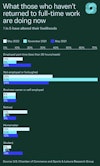
Among those currently unemployed who have held multiple jobs since April 2020, 60% lasted three months or less in their most recent job. More employees made the decision to leave their most recent job as opposed to being terminated (26% reported being terminated, compared to 48% in November 2021). Close to one third (31%) left for personal reasons, 18% left because they were dissatisfied with the job, and 14% left due to a lack of advancement opportunities with their previous employer.
Returning to work has become less of a priority
Over half (52%) of those who lost their full-time job during the pandemic agree that it is essential to return to full-time work as soon as possible (down from 67% in November 2021). Meanwhile, only a third (34%) want to return to work full time.
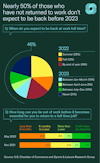
When asked when they expect to be back at work full time, 55% said by the end of 2022. Meanwhile, 21% said they will never return to full-time work.
Some are getting by with government aid and unemployment benefits
One in six (17%) of those not actively looking for a job strongly agree that government provided benefits are good enough for them. Almost a quarter (24%) say government aid packages during the pandemic have incentivized them to not actively look for work. Meanwhile, one in five have been able to channel money from government programs like rent or mortgage assistance to help make ends meet.
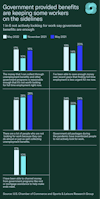
Health concerns and caring for others are top reasons why they aren’t actively looking
Over a quarter (28%) of respondents say they’ve been ill, and their health has taken priority over them looking for work (unchanged from November 2021). Additionally, 27% say the need to be home and care for children or others has made it difficult or impossible to search for full time employment (this is up four points from November 2021). Still, women were more likely to say that staying home to care for children or others in the family is a barrier for them returning to work (36%, compared to 16% of men).

Younger respondents, aged 25-34, are prioritizing personal growth over searching for a job right now; 36% say they’re more focused on acquiring new skills, education or training before re-entering the job market.
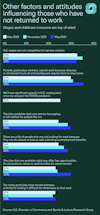
Incentives to bring people back to work have lost some of their impact
When asked what would increase their urgency to return to full time employment, the top three incentives were a hiring bonus of $1,000 (36%, down from 46% in November 2021), flexible work hours (31%, down from 43% in November 2021), and a positive work environment (30%, down from 41% in November 2021).
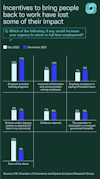
The option to work remotely is extremely favorable. Three in four (73%) are strongly opposed to jobs that require you to be in the office full-time. About half (49%) of the unemployed are not willing to take jobs that do not offer the opportunity for remote work; one in four (24%) are strongly opposed.
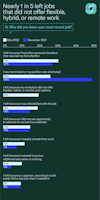
Nearly one in three want to, and expect to, switch industries
Just under a third (30%) prefer to work in a different industry than the one they last worked in (statistically unchanged from the 32% who said the same in November 2021). If they return to work, 30% said they are likely to switch industries. Of those likely to change industries, 39% previously worked in leisure/hospitality, 32% in retail, and 29% in manufacturing.
Download the full report findings
The U.S. Chamber of Commerce and the U.S. Chamber of Commerce Foundation launched America Works, a nationwide initiative mobilizing industry and government to swiftly address America’s deepening worker shortage crisis. Discover workforce solutions, find additional research and analysis, and explore the full America Works policy agenda at uschamber.com/work.
The poll of 514 Americans who lost jobs during the pandemic and have not returned to full-time employment was taken May 18-24, 2022. The poll has an overall survey margin of error +/-4.3% at the 95% confidence level, with Stable and Projectable bases, quotas across age, prior total compensation, ethnicity, incidence of children at home, industry sector and educational attainment. As with the prior wave of this wave of research, respondents over the age of 65 were excluded from the study.
Learn More
Pandemic Unemployed Survey May 2022
About the authors

Megan Ayala
Megan Ayala is a Manager of Program Operations for Team AIM and the Global Innovation Policy Center (GIPC).

Isabella Lucy
Isabella has created stunning visualizations tackling pressing issues like the worker shortage, the benefits of hiring veterans, the lifespan of small businesses, and the future of work.





